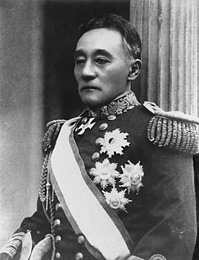Kawamura Sumiyoshi
|
Count Kawamura Sumiyoshi |
|
|---|---|

Japanese Admiral Kawamura Sumiyoshi
|
|
| Native name | 川村 純義 |
| Born |
December 18, 1836 Kagoshima, Satsuma domain, Japan |
| Died | August 12, 1904 (aged 67) Japan |
| Allegiance |
|
| Service/branch |
|
| Rank | Admiral |
| Commands held | Imperial Japanese Naval Academy |
| Battles/wars | |
| Other work | Navy Minister, Privy Councillor |
Count Kawamura Sumiyoshi (川村 純義?, 18 December 1836 – 12 August 1904), was an admiral in the Imperial Japanese Navy. Kawamura's wife Haru was the aunt of Saigō Takamori.
A native of Satsuma, Kawamura studied navigation at Tokugawa bakufu naval school at Nagasaki, the Nagasaki Naval Training Center. In 1868, he joined his Satsuma clansmen, and fought on the imperial side in the Boshin War of the Meiji Restoration as an army general. He was especially noted for his role in the Battle of Aizu-Wakamatsu.
Under the new Meiji government, he became an officer in the fledgling Imperial Japanese Navy, and steadily rose through the ranks. He became first Director of the Imperial Japanese Naval Academy in 1870 and taifu (senior vice minister) of Navy in 1872. He was in command of Japanese naval forces during the Taiwan Expedition of 1874.
During the Satsuma Rebellion, he was placed in command of all Imperial troops in September 1877 at the final Battle of Shiroyama near Kumamoto, when Saigō Takamori was killed (or committed seppuku). This battle, Saigō's last stand against the Meiji government, was the historical basis for the 2003 film The Last Samurai.
...
Wikipedia
